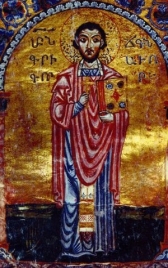Grigor Narekatsi
Wednesday, April 16, 2025
The son of a bishop, Gregory was educated, ordained, and later stationed at Narekavank on the southern shores of Lake Van (modern Turkey). Scholars consider Gregory the most beloved and significant theological and literary figure of the Armenian religious tradition.
He is best known for his Book of Lamentations, a significant piece of mystical literature that serves as a confessional prayer book in many Armenian religious households. His works have inspired many Armenian literary figures and influenced Armenian literature in general throughout the ages.
Scholars place Gregory's birth and death dates circa 945–951 and 1003 or 1010–11, respectively. He lived in the Kingdom of Vaspurakan, a medieval Armenian kingdom, which is "notable for the high cultural level that it achieved."Vaspurakan, centered around Lake Van, is a region described by Richard Hovannisian as "the cradle of Armenian civilization".
Little is known about his life. He was born in a village on the southern shores of Lake Van, in what is now eastern Turkey, to Khosrov Andzevatsi, a relative of the Artsruni royal family.His mother died when he was little. Khosrov was ordained a bishop after being widowed and was appointed primate of the diocese of Andzevatsik. His father was suspected of pro-Byzantine Chalcedonian beliefs, a doctrine not accepted by the Armenian Apostolic Church,and was eventually excommunicated by Catholicos Anania Mokatsi for undermining the Armenian Church with his interpretation of the rank of Catholicos, the highest rank in Armenian church clergy, as being equivalent to that of a bishop, a lower rank in Christian churches, based on the works of Pseudo-Dionysius the Areopagite, a fifth-century Greek Christian theologian and mysticist. Grigor and his elder brother Hovhannes were sent to the Narekavank (lit. the monastery of Narek), where he was given religious education by Anania Narekatsi (Ananias of Narek). The latter was his maternal great-uncle, a celebrated scholar and the monastery's founder. Being raised in an intellectual and religious fervor, Grigor was ordained priest in 977 and taught others theology at the monastery school until his death.
Whether Gregory led a secluded life has become a debate among Armenian scholars. Both literary critic Arshag Chobanian and scholar Manuk Abeghian believe he did. In contrast, literary critic Hrant Tamrazyan argued that Gregory was very well aware of the secular world and his time, had a deep knowledge of both peasants and princes and the complexities of the world. Tamrazyan believes he could not have lived solely on literary ecstasy.[
Gregory was buried inside the walls of the monastery of Narek. A rectangular-shaped chapel-mausoleum was built on his tomb, which survived until the mid-20th century, when the monastery, abandoned in the aftermath of the Armenian genocide, was destroyed by the Turkish authorities, and later replaced with a mosque.





